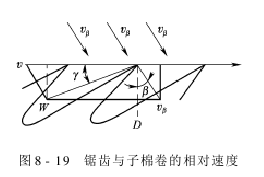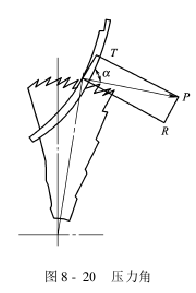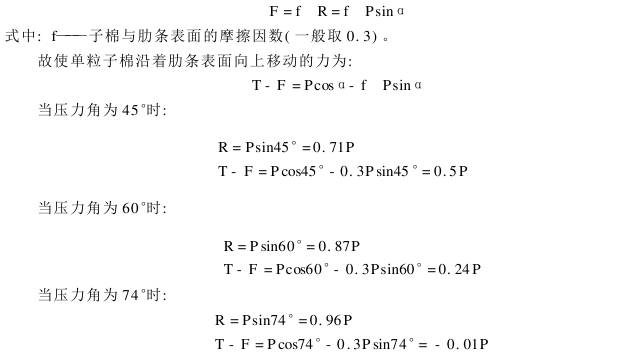Zigzag ginning theory Separation of fibers and cotton seeds
On the arc length from the cotton comb to the working point of the ginning rib, the saw teeth and the cotton rolls are in contact with each other. Due to changes in working conditions such as cotton properties, cotton lap density, gin productivity, saw blade drum speed, etc., the interaction between the saw teeth and cotton laps is very complex.
So far, there is no mathematical model for website building to describe the relationship between saw teeth and sub-rolls.
(1) The effect of saw teeth on cotton
Saw tooth ginning relies on the saw teeth to pierce the cotton fiber layer, so that the fibers are embedded in the tooth recesses, and then try to pull them off the cotton. Two conditions must be met for sawtooth ginning.
.
On the arc section from the cotton comb to the working point of the ginning rib row, as the linear speed direction of the saw tooth surface and the linear speed direction of the sub-cotton roll surface change, the effect of the saw teeth on the sub-cotton roll and sub-cotton also changes. . The saw teeth have three functions on the cotton roll and cotton.
(1) The saw teeth hook the fibers on the cotton, causing the fibers to enter the saw tooth notches; (2) the saw teeth pull the cotton roll, making the cotton roll rotate and relax; (3) the saw teeth pull the fibers off the cotton , to separate fibers and cotton seeds.
Research shows that: in D area, saw teeth mainly have a kind of effect on seed cotton, and the second and third effects are very little; in Ji area, saw teeth mainly have a third effect on seed cotton, and the second effect is secondary. , there is almost no seeding effect; in area E, sawtooth has the second and third effects on seed cotton, and the seeding effect is small.
(2) Analysis of saw teeth causing fibers to enter the tooth recess
From Figure 8-19, we can see the leisure direction of the surface of the cotton roll. In area D, the leisure direction of the sub-cotton roll is inconsistent with the leisure direction of the sawtooth. Assumption:

(1) The speed of the sub-roll in area D is vβ, and the speed direction forms an angle β with the radial line of the saw blade; (2) The sawtooth speed in area D is v.
Then, the angle between v and vβ is (90°-β). The relative speed W of the sawtooth and sub-roll can be obtained according to the following vector formula:

In this way, once the single particle cotton in the sub-cotton roll comes into contact with the saw teeth, the fibers on the sub-cotton enter the saw tooth notch at a speed W. Now, it is very simple to prove the role of sawtooth on seed cotton. In area D, the value of vβ is larger and the β angle is less than 90°. The value of v is a constant, so the direction of W must point to the sawtooth notch, that is, in area D, the sawtooth has a stronger effect on making fibers enter the tooth recess. The sawtooth has a strong ability to pick up cotton in this area, and the number of cotton picks up is large. In the E area, the value of vβ is large, but the β angle is approximately 90°, making the γ angle very small, or even zero, so the direction of W is difficult to point to the sawtooth notch, that is, in the E area, the sawtooth causes the fiber to enter the tooth recess. The effect of the saw teeth is very small, and the ability of the saw teeth to catch cotton in this area is very weak. In the self-area, because the β angle is greater than 90°, the direction of W must be away from the sawtooth notch, that is, in the self-area, the sawtooth cannot make the fiber enter the tooth recess.
In Areas E and J, the β angle of the single particle cotton on the surface of the cotton roll is sometimes less than 90°, so that the seeding effect of the saw teeth on the cotton is compensated in Areas E and J. Further research found that the above rules may not be accurate in very few cases, mainly due to changes in sub-lap density, operating conditions and other factors.
(3) The saw teeth separate the fibers and cotton seeds
Most of the fiber bundles hooked by the saw teeth in the D area reach the working point, enter the gaps between the embossed rib rows, and separate from the cotton seeds.
The cotton that moves to the working point with the saw teeth immediately changes its direction and speed after encountering the embossed rib row, and relaxes upward along the surface of the rib row. The speed of the cotton roll here is slow, 1.1~1.5m/s, but the density is high at this time. At the working point of the embossing rib, the ability of the saw teeth to pull fibers off the cotton has a great relationship with the relative position between the embossing rib and the saw blade. The relative positional relationship between the embossed rib and the saw blade is generally expressed by the pressure angle. The pressure angle is the angle between the tangent line of the arc at the working point of the embossed rib and the tangent line of the saw blade circumference, represented by the letter α, as shown in Figure 8-20.

In rolling At the working point of the flower rib, the moment the saw teeth pull the fibers off the cotton, the operating force P of the saw blade can be decomposed into two mutually perpendicular components R and T. The relationship between the three is as follows:
R=Psinα
T=Pcosα
Among them, the direction of P is consistent with the leisure direction of the saw teeth at the working point; R is perpendicular to the embossed rib, which is the direction of the saw teeth at the working point. The force that pulls off the fiber on the cotton; T is parallel to the ginning rib, and is the force of the saw teeth at the working point to push the cotton lap to run. Under the action of the component force R perpendicular to the embossed ribs, a friction force F is generated between the cotton and the rib surface. The direction of F is opposite to the direction of T, and its value is:

The above calculation shows that: as the pressure angle increases, the work The serrations at the points pull out the fibers from the cotton.It is strong and easy to brush. The saw blade has few missing teeth, which ensures the pulling of fibers from the number of teeth. Therefore, the more complete the saw teeth, the better, and the fewer defects, the better.
But there is a limit to the sharpness of the saw teeth, because if the saw teeth are too sharp, they will easily pierce the cotton, increase the fiber-laden lint and lint, and the edges of the saw teeth will easily chew off the lint on the cotton. Generally, for cotton with high finishing grade, good maturity and low moisture content, the saw teeth should not be sharp. The solution to overly sharp saw teeth is to sand the saw blade drum in a sand box. The newly punched saw blade has many edges and corners on the tooth surface, has hair cracks, and has poor cleanliness. After being assembled into a saw barrel, it needs to be sanded before it can be used for finishing. Sanding the saw barrel can not only improve the cleanliness of the saw teeth, but also solve the problem of the saw teeth being too sharp. Therefore, sanding the saw barrel is an indispensable part of the saw barrel installation and maintenance process.
The technological requirements for the sawtooth state are that it is sharp and clean, without crooked or inverted teeth, and the number of missing teeth on each saw blade does not exceed the specified value.
AAAEHRYJUTUTHYER







